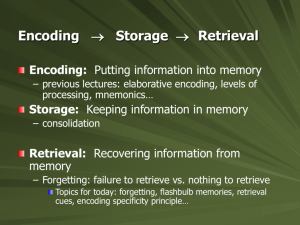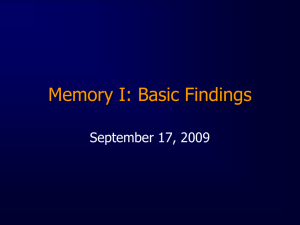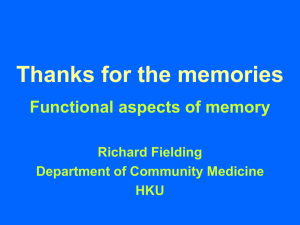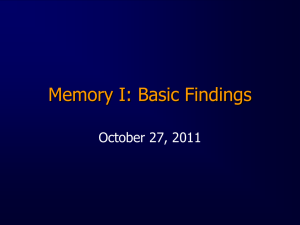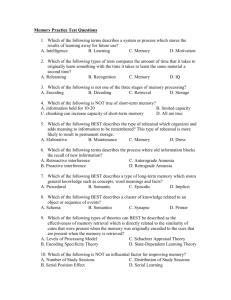Memory I
advertisement
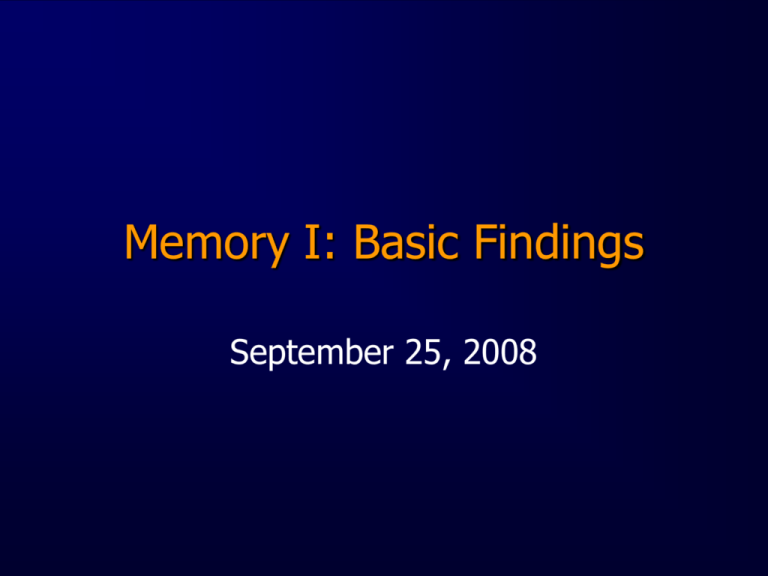
Memory I: Basic Findings September 25, 2008 Types of Memory (semantic) (episodic) Major Historical Landmarks • Basic Phenomena – Hermann Ebbinghaus’ “Uber das Gedächtniss” (1885): first major treatise on empirical study of memory – Bartlett (1932): role of schemas – Modal Model (Atkinson & Shiffrin (1968) – Early work on STM: Sternberg’ search processes, Murdock’s forgetting functions, Wickens’ release from PI – Organizational processes in memory: Mandler, Tulving, Neisser • Processing Accounts – Levels of Processing: Craik & Lockhart (1972) – Encoding-specificity Principle: (Tulving & Thomson, 1973) correspondence of processes at encoding and retrieval is important – Working Memory: Baddeley & Hitch (1974) – Mnemonics including imagery: (Paivio, Bower) • Multiple System Views – Episodic v. Semantic Memory: (Tulving) – Implicit vs. Explicit Memory: (Schacter, cast of thousands) – Structure of Semantic Memory: (Collins & Quillian) • Contributions from Neuropsychology: (Milner, Squire, Cermak, Butters, Warrington, Weiskrantz, etc.) Structures vs. Processes • Structures: localized components of memory system (e.g., stores, scratchpads) – iconic, echoic store – short-term memory, long-term memory • Processes: activities comprising the “work” of memory (e.g., semantic vs. phonological encoding, retrieval) Key Distinctions • Time – Immediate vs. recent vs. remote memory • Content – Episodic (autobiographical) vs. semantic memory • Mode of Retrieval – Explicit vs. implicit memory (processes, systems) – Declarative vs. nondeclarative knowledge • Tasks (NOT processes!) – Direct vs. indirect memory Direct Memory Measures • Recall of facts or events – serial recall: recall in the same order as learned – free recall: recall in any order – cued recall: given some cue to stimulate retrieval • Recognition – multiple choice – yes-no – free-field Indirect Memory Measures • Measures of facilitated responding (priming) – Lexical decision – Reading time – Fragmented picture identification • Measures of skill learning – Motor – Conceptual (0,1,1,2,3,5,8….) The Multi-store Model of Memory (Modal Model) Atkinson & Shiffrin (1968) Sensory (Iconic) Store - Sperling • Highly accurate, rapidly decaying buffer • Contains more information than we normally report on, but lost quickly • Paradigm: present 12 letters (50ms), provide cue either before or at some point after the letter array is presented H P Y X L S N T C R W F Proposed duration of sensory memory = 0.5s Proposed Properties of STS • Limited Capacity – digit span, recency measures – Miller’s “magic number 7+2” • Coding – material specific – acoustic – visual • Forgetting from STS – Decay (passive) – Interference (active) Waugh & Norman (1965) Stimulus Primary Memory (STM) Forgotten Rehearsal Secondary Memory (LTM) “What # followed last # initially?” Digit Probe Task 7 9 5 1 2 9 3 8 0 4 6 3 7 6 0 2[tone] Answer: “9” Waugh & Norman (1965) Digit Probe Task results Free recall as a function of serial position and duration of the interpolated task. Adapted from Glanzer and Cunitz (1966). STM? LTM? Forgetting over time in short-term memory. Data from Peterson and Peterson (1959). Interference Paradigms Wickens (1972) Release from PI Evaluation of Modal Model • Most assumptions are incorrect or can account for only a part of the data • Can’t account for patients with intact LTM with impaired STM • Oversimplified • De-emphasizes the roles of proactive interference and of retrieval cues in short-term memory and forgetting Forgetting from LTM • Mechanisms – Poor encoding • Levels of processing account – Interference – Decay – Poor retrieval (cue-dependent forgetting) • Key phenomena – Encoding specificity – Retrieval-induced forgetting (automatic?) – Directed forgetting (voluntary?) They used to call it “short-term memory”, but that’s so not cool now. Who invented “working memory”? Alan Baddeley G.A. Miller E. Galanter Miller, G. A., Galanter, E. & Pribram, K. H. (1960). Plans and the structure of behavior. New York: Holt, Rinehart & Winston. K.H. Pribram Cognitive Single-cell electrophysiology Psychology Working Memory Cognitive Neuropsychology Functional Neuroimaging Working Memory • A system which keeps a representation of information active and “on line” for immediate future use (short-term memory) • Involves the “temporary storage and manipulation of information that is assumed to be necessary for a wide range of cognitive functions” (Baddeley) • Demands: storage v. manipulation • The more studies, the more complex it gets: Multi-componential/material-specific (e.g., verbal vs. nonverbal; maintenance v. manipulation) Clinical Techniques and Methods • Verbal – Memory Span (digits, consonants, words) – Free Recall – Short-term forgetting (Peterson/Peterson) – Memory Probe Techniques – Prose Recall Experimental Techniques and Methods • • • • • Spatial delayed response Oculomotor delayed response Delayed matching-to-sample Attentional set-shifting N-back Immediate word recall as a function of modality of presentation (visual vs. auditory), presence vs. absence of articulatory suppression, and word length. Adapted from Baddeley et al. (1975). Features of the Phonological Loop • Two features: – Phonological store • Auditory presentation of words has direct access • Visual presentation only has indirect access • Vallar and Baddeley (1984) – Articulatory process Evaluation of the Evidence for the Phonological Loop • Accounts for phonological similarity and the word-length effect • Support from neuroimaging studies • Baddeley, Gathercole, and Papagno (1998) – Its function may be to learn new words – Also probably important in aspects of language comprehension Visuo-spatial Sketchpad • Used in the temporary storage and manipulation of spatial and visual information • Baddeley et al. (1975) – The pursuit rotor task-impairs performance on location visualization task • Logie (1995) – Visual cache – form/color (ventral?) – Inner scribe – spatial and movement (dorsal?) Evidence for the Visual Cache and Inner Scribe • Quinn and McConnell (1996) – differential interference from spatial v. visual tasks – The method of loci (visual) – The pegword technique (visual + spatial?) • Beschin, Cocchini, Della Sala, and Logie (1997) – Evidence from NL, who had suffered a stroke – left represeentational neglect • Smith and Jonides (1997) – Probe location or form- different PET activation (right frontoparietal for spatial; left parietotemporal for visual form) Evaluation of the Visuo-spatial Sketchpad • Supported by imaging research that shows the independence in spatial and visual tasks • Consistent with ventral-dorsal visual pathway concept • Support from studies of brain-damaged patients • Many tasks require both components • Not clear how information is combined and integrated Central Executive • Baddeley (1996, p. 6) admitted – “our initial specification of the central executive was so vague as to serve as little more than a ragbag into which could be stuffed all the complex strategy selection, planning, and retrieval checking that clearly goes on when subjects perform even the apparently simple digit span task.” • Concept of central executive has evolved as an attentional system Functions of the Central Executive • Baddeley (1996) identified the following functions: 1) switching of retrieval plans 2) timesharing in dual-task studies 3) selective attention to certain stimuli while ignoring others 4) temporary activation of long-term memory Evidence for the Central Executive Task: Hold “x” digits in mind while generating random number sequences Randomness of digit generation (greater redundancy means reduced randomness) as function of concurrent digit memory load. Data from Baddeley (1996). Evidence for the Central Executive • Collette and Van der Linden (2002, p. 120) reviewed numerous brain-imaging studies involving several central executive functions • “Some prefrontal areas (e.g., BA9/46, 10, and anterior cingulate gyrus) are systematically activated by a large range of various executive tasks, suggesting their involvement in rather general executive processes. However, other frontal areas . . . and even parietal regions . . . are also frequently found during the execution of executive tasks. Since these regions are involved less systematically in the different executive processes explored in this review, we can hypothesise that they have more specific functions.” Episodic Buffer Experimental Techniques and Methods • • • • • Spatial delayed response Oculomotor delayed response Delayed matching-to-sample Attentional set-shifting N-back Verbal 3-Back Task • table boy porch deer boy fence deer boy Spatial 3-Back Task • A • X • • C • R M • • M R • X • Working memory and associative memory may be distinguished using the delayed response task When PFC-lesioned monkey must remember which well is baited from trial to trial, performance is poor When PFC-lesioned monkey must remember which symbol is baited from trial to trial, performance is good Patricia Goldman-Rakic (1937-2003) Goldman-Rakic, 1996 Cohen et al., 1998 Cohen et al (1998); memory structures active during delay Two views about specificity in WM • Domain-specificity (Goldman-Rakic, Ungerleider, Courtney) – Ventral prefrontal: object working memory – Dorsal prefrontal: spatial working memory • Process-specificity (Petrides, D’Esposito) – Ventral prefrontal: sequential organization and storage – Dorsal prefrontal: executive control and monitoring Storage Exec + Storage Smith & Jonides 1999 Processing Components of Memory • Encoding: activities taking place during presentation of TBL information (study phase) • Storage: activities taking place during the study-test interval • Retrieval: activities taking place when stored information is utilized (test phase) Encoding • Encoding I: bringing information processing to bear on TBR information • Encoding II: utilizing the fruits of Encoding I as a means for transferring information from STM to LTM • Examples: elaborative rehearsal, semantic association, imagery, other strategies Levels of Processing • Emphasizes encoding processes • Craik & Lockhart (1972) – memory is byproduct of cognitive processes engaged during learning – notion of “levels”; depth defined in terms of meaningfulness rather than on number of operations – rehearsal • important for maintaining information at a given level of analysis • important for elaborating or processing info to a deeper level – Craik & Tulving (case, rhyme, semantic levels) • Maintenance: repeating previous analyses • Elaboration: deeper, more semantic analysis Processing time • In Craik & Tulving’s previous experiment, ‘deeper’ levels took more time (longer RT) • Is the effect due to processing time? • Exp 5: Structural (note pattern of consonants, make a word [e.g., ccvvc=brain] vs. semantic (sentence verification) 1.8 1.6 1.4 1.2 1 0.8 0.6 0.4 0.2 0 Structural Semantic Time Recog Problems with LOP interpretation • No independent measure of “depth” • “Deeper” isn’t always “better”: Morris, Bransford, & Franks (1977) Semantic Encoding Rhyme Encoding TEST TYPE Standard .83 .62 Rhyme .31 .49 •Conclusion: memory performance not just a function of depth, but depends on the match between encoding processes and type of test Storage/Consolidation • Consolidation: process by which information is integrated into stored information • Thought to be dependent on hippocampal-cortical interactions • Can take place quickly or over many years (“fast” and “slow” consolidation) • Consolidation and retrograde amnesia RA at 2 weeks RA at 6 months trauma Theories of Forgetting • Decay (trace dependent forgetting) • Interference • Cue-dependent forgetting (encoding specificity) – Selective rehearsal – Inhibition/suppression Cued recall as a function of the number of times the cues had been presented before for recall (respond condition) or for suppression (suppress condition). Data from Anderson and Green (2001). Mood-state-dependent Memory • Free and cued recall as a function of mood state (happy or sad) at learning and at recall. Based on data in Kenealy (1997). Effect present for free recall but not cued recall. Shows that mood state effects memory particularly when no other powerful retrieval cues are available. Evidence for Encoding Specificity Principle Strong = strongly associated Weak = weakly associated • Mean word recall as a function of input cues (strong or weak) and output cues (strong or weak). Data from Thomson and Tulving (1970). Context Dependent Memory • (a) Recall in the same vs. different contexts, data from Godden and Baddeley (1975); (b) Recognition in the same vs. different contexts. Data from Godden and Baddeley (1980). Original learning, total free recall, and total free cued recall as a function of the number of lists presented after learning. Data from Tulving and Psotka (1971).


